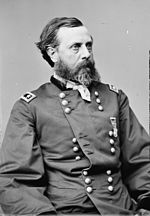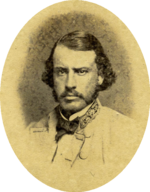Battle of Walker's Ford
Major General Ambrose Burnside launched the Union invasion of East Tennessee in late August 1863, using two infantry divisions and cavalry from the XXIII Corps stationed in Kentucky.
Burnside consolidated his control of the region at the Battle of the Cumberland Gap when he accepted the surrender of its 2,000-man Confederate garrison on September 9.
[5] The strength returns for October 1863 showed that Willcox's Left Wing Forces in East Tennessee counted 178 officers and 4,213 enlisted men present for duty.
[7] Colonel Wilson C. Lemert's brigade from IX Corps formed the garrison of Cumberland Gap but its troops were not counted as part of Willcox's Left Wing.
Burnside rapidly moved the IX Corps troops to defeat Williams at the Battle of Blue Springs on October 10 and chased the Confederates back to Virginia.
Bragg was upset with Longstreet's bungled attempt to cut the Army of the Cumberland's newly established Cracker Line at the Battle of Wauhatchie on October 28.
Willcox dispersed his infantry in order for the soldiers to forage for food and posted most of his cavalry near Tazewell to observe Longstreet.
[18] At this time, Major General Ulysses S. Grant planned to attack Bragg's Confederate army near Chattanooga, but he experienced delays.
Hearing by telegraph from Grant that the Battle of Missionary Ridge had commenced, Willcox passed this information through the siege lines to Burnside via secret messenger.
[20] Burnside had requested to be relieved of command, but his replacement, Major General John G. Foster did not reach Cumberland Gap until November 30.
Following the Straight Creek Road, Graham crossed the Clinch River at Walker's Ford and reached Maynardville on November 29.
Longstreet responded to Graham's incursion by ordering Brigadier General Frank Crawford Armstrong's division to oppose it.
Armstrong withdrew his two brigades under Colonels George Gibbs Dibrell and Thomas Harrison from Cherokee Heights on the south side of Knoxville on November 30 and crossed to the north bank.
[22] Leaving Cumberland Gap with a minimum garrison and with Foster's approval, Willcox started south toward Tazewell with the infantry on December 1.
Leaving Company M, 5th Indiana Cavalry in Maynardville as a picket, Graham's brigade marched northeast and stopped at 5 am on December 2 at Brock's House, about 4 mi (6.4 km) south of Walker's Ford.
Graham's cavalrymen withdrew a short distance to Yeadon's Farm where they dismounted and formed along a fence line, their position buttressed by a log house that they converted into a fort.
After more fighting, the 11th Tennessee dismounted and turned the Union right flank, causing Graham to order a retreat closer to Walker's Ford and ask for assistance.
Meanwhile, Willcox set out from Tazewell at dawn on December 2 and reached the north bank of Walker's Ford with Colonel George W. Jackson's brigade.
Showing remarkable spunk for untested recruits, the Indiana foot soldiers formed a line about 1 mi (1.6 km) south of Walker's Ford and let the cavalry,[26] which was almost out of ammunition,[23] retreat through them.
Anticipating that his opponents were trying to outflank his position, Graham ordered Colonel Horace Capron to take his 14th Illinois Cavalry Regiment and cover the next ford.
[29] The unit that arrived at the ford at Black Fox Creek was the 129th Ohio Infantry Regiment,[20] which was part of Lemert's IX Corps brigade.
Hess called the battle a Union tactical victory, but it was barren of strategic results because Martin blocked Willcox's cautious probe.






